Table of Contents
Task One – Standard Operations Guide for Technow Recruitment
An assessment of each of the different stages of the employee lifecycle (AC 1.1)
People practice practitioners must consider the employee lifecycle in managing employees. The employee lifecycle model expresses and identifies the major stages that workers go through as they engage with their organisation. Essentially, the employee lifecycle has six major stages: attraction, recruitment, onboarding, development, retention, and separation. Effective employee attraction is important towards ensuring the right candidates are attracted and retained in the organisation (SpriggHR, 2020). It is therefore important to maintain some best practices. This may entail promoting the organisation’s brand, having a great culture represented in the employee value proposition and providing competitive benefits.
Similarly, it is important to ensure transparency and fairness during recruitment and selection. Some best practices during recruitment to ensure the best candidates are onboarded include using employee referrals and different platforms to diversify the talent pool. In addition, the onboarding stage is also important since it allows employees to acclimate to their job roles and the organisation’s culture. Organisations need to have a job description and discuss the company values, vision, and expectations with new hires to succeed. Employee development is also important and entails encouraging professional development among workers and helping them improve their skills (SpriggHR, 2020). Similarly, career development entails providing them with a future career path. Some strategies for encouraging employee development include encouraging external learning, assessing employee skills and encouraging employees to be responsible for their development. Besides, an employee who learns on their own time should also be rewarded.
Employee retention is also an important stage where people practice professionals expand efforts to ensure the best employees are retained and are satisfied to be part of the team. Employee retention can be enhanced by ensuring the right employees are hired. Similarly, it is important to foster great relationships with them and communicate openly and frequently about the team mission. Furthermore, it is important to seek employee feedback to gather their opinions on how best to address their issues. The aforementioned should also transcend to the last employee separation stage, where it is prudent to administer exit interviews to understand their reasons for leaving.
Stages and different methods are available within the recruitment process, and when appropriate, use each of them. (AC 1.2)
Defining the role
The first stage in the recruitment process is identifying and defining the role for which recruitment and selection are to be carried out. The aforementioned is achieved through job analysis and developing a job description. in essence, job analysis refers to how people practice professionals spend time gathering information from different sources to establish whether a position is new or already exists. This information is then used to develop a job description and personal specification. When carrying out job analysis, the purpose and duties of the job should be identified. Similarly, how and where the job will be carried out, and the responsibility of the job holders should be defined.
The job description developed at the job analysis stage provides details about the responsibilities and objectives of the role and is integral when carrying out performance management. On the other hand, the person specification provides the desired characteristics and qualifications of the job holder. Therefore, the job specification must be clear and free from bias.
Attracting applicants
Attracting applicants is equally an important stage in the recruitment process. to ensure effective recruitment and selection, people need to practice professionalism to develop effective job advertisements (Russell, 2020). The job advertisements should provide clear and accurate information regarding the advertised role and the organisation. It should also indicate the job description, person specification and location. In addition, the type of employment and benefits package should also be indicated. It is important to point out that there are several methods that organisations can use to attract candidates for open positions. They include;
Employee referral schemes
Rather than developing external job advertisements, some organisations may use an employee referral scheme where existing employees assist in the recruitment process by recommending friends and other contacts. Employee referral programs are preferred because they reduce the costs of advertisements, and there is a high likelihood that the employees will recommend qualified candidates.
External recruitment
Organisations may also opt to attract employees externally through external recruitment methods. Such methods may include advertising the job position on their websites, commercial job boards, and recruitment agencies, attending job fairs and posting advertisements on professional networking sites. A key benefit is diversification of the talent pool and a better likelihood of attracting and recruiting the right person.
Managing application and selection process and making an appointment
Another stage in the recruitment process is managing employee applications and selecting to make the right appointment. To ensure the right employees are appointed, several processes may be used, including issuing application forms, analysing candidates’ CVs, and LinkedIn profiles that give details regarding an employee’s suitability. Notably, the selection of employees can take two different forms, including shortlisting proves where employees whose skills and qualifications make them suitable for appointment (Russell, 2020). On the other hand, the assessment may take the form of interviews and assessment centres. When making an appointment, people practice professionals must ensure that the appointed employee meets all the job requirements and is permitted to work in the UK.
Different methods and techniques can be used to prepare and provide information for the various parts of the recruitment process for specific roles. (AC 1.3)
Job analysis
Organisations can use job analysis to prepare and provide information on numerous parts of the recruitment process for given roles; job analysis refers to the systematic process of studying a job to determine its activities and responsibilities, its importance to other jobs, the qualifications required for one to execute it and the conditions under which the job is performed (Leverage Edu, 2020). Notably, information revealed by job analysis may be presented in the form of a job description and job specification. The job description features the job title, job location, job summary, working conditions, duties and hazards. On the other hand, the job specification contains information such as qualifications, experience, training skills, responsibilities, sensory demands, and emotional characteristics (CIPD, n.d.).
Job design
Job design refers to organising tasks and establishing employee responsibilities, systems and procedures that they must use or follow. Job design is instrumental in ensuring effective coordination and optimisation of work processes to create value and maximise performance (Leverage Edu, 2020). Besides, it is worth noting that information derived from job design can contribute to creating good quality jobs that benefit employees and organisations.
An assessment of the different materials and methods can be used to attract talented individuals internally and externally for a range of roles. (AC 1.4)
Internal attraction
Internal job postings
Organisations can opt to attract employees internally through internal job postings where employees are encouraged to apply (Brighthr, 2022). Notably, internal job postings can appear in emails to members of staff bulletin boards, company intranet or internal newsletters. Huan resource managers can also be tasked with communicating internal job postings for all employees who are eligible to apply. Internal job postings have some advantages, including providing a career development path for employees and increased job satisfaction. Nevertheless, it limits the talent pool search, and the organisation may still have to recruit externally.
External attraction
Company websites
Organisations may also attract talented individuals by posting available jobs with their job description, person specification and value proposition on their company websites. Notably, some of the advantages are that software tools such as Google can be used to amplify the advertisements hence a wider reach and talent pool. Besides, advertisements on websites ensure potential applicants have full information about the organisation hence easier onboarding. Nevertheless, company websites may attract unqualified employees.
Task Two – Interview Preparation Pack.
Selection methods that are used to assess the suitability of candidates and when it is most appropriate to use each method (AC 2.1)
Interviews
Following a shortlisting process, people practice professionals or recruitment professionals may use interviews to facilitate the selection. Interviews entail formal in-depth conversations between applicants and employers to ascertain the applicant’s acceptability. Notably, interviews provide the employer and the employees with opportunities to understand and learn from one another. For instance, interviews allow employers to assess potential candidates’ experience and ability to perform in the advertised role. In addition, interviews are opportunities for employers to explain their value proposition and identify the learning opportunities for employees and the benefits offered. Finally, it is also an opportunity for the employer to provide a positive impression regarding the organisation to attract employees.
Regarding candidates’ interviews are opportunities for them to improve their understanding of the jobs and responsibilities to demonstrate their ability to handle the responsibilities associated with the job and decide whether or not they will take the job. However, it should be noted that compared to psychometric tests, interviews are more prone to the stereotyping effect, which may lead to qualified candidates being left out. Besides, interviews are prone to contrast effect where the interviews experience of interviewing one candidate affects how they interview others hence skewing the interview.
Psychometric testing
Psychometric testing can be used to ensure the selection of the right employees. Furthermore, evidence has shown that standardised tests and those that test employees’ cognitive abilities can indicate an employee’s future job performance (Maxwell, 2021). Besides, when applied correctly, psychometric tests can allow organisations to systematically assess employees’ abilities, aptitudes, and personalities, particularly when dealing with a large pool of applicants. Nevertheless, it is worth adding that psychometric tests may be inaccurate, especially when cultural biases are present. In addition, answers are fixed hence prone to cheating.
Assessment centres
Assessment centres may also be used to facilitate the selection process. Assessment centres entail candidates being asked to carry out a series of tasks and activities encompassing cognitive and personality tests and behavioural ratings. Notably, the aforementioned tasks and activities often reflect the person specification of the advertised job (Maxwell, 2021). Selection of employees through assessment centres presents some advantages and disadvantages. For instance, they can be used to find candidates’ strengths and weaknesses. Besides, in comparison to interviews, they reduce the possibility of bias since different candidates evaluate candidates. Nevertheless, they are expensive and time-consuming to conduct and may be ineffective where selection is required within a short period.
Discuss the records that need to be retained following a selection process (AC 2.4).
It is imperative to acknowledge that employers keep numerous applicants’ data during recruitment and selection. In particular, some of the records that employers collect include application forms, CVs and cover letters (CIPD, 2020). It is also important to note that the aforementioned documents, including other records used to facilitate the selection process, such as the job description, person specification, selection matrix, and interview notes, should also be retained by the employer.
According to The General Data Protection Regulation (GDPR), employers are legally allowed to keep candidates’ records for up to six months if the candidate is unsuccessful. This is because an applicant can lodge a claim against the organisation for discrimination within this period. Moreover, apart from safeguarding records for use in the event of litigation, they may also be kept to build the talent pool and enhance the process of recruitment and selection in the future.
Task Three – Simulated Interview with peers
Selection criterion from the personal specification for the appointment of a line manager. (contributes to AC 2.2)
| Post title: Line manager | |
| Essential | Desirable |
| Knowledge and qualifications | |
· Bachelors degree or equivalent qualification · CIPD qualification |
|
| Experience | |
|
|
| Skills and competencies | |
| |
| Personal qualities | |
| |
Shortlisting applications against the selection criteria to determine candidates to be interviewed. (contributes to AC 2.2)
Shortlisting Matrix
Contributing to a face-to-face, telephone or web conferencing interview as part of a panel using an appropriate interview structure. (AC 2.3)
Telephone Interview Transcript
Recorded from 12: 00 pm
Interviewee: Alicia
Interviewer: Marcus
The phone interview begins
Marcus: Good afternoon Alicia am Marcus, a recruitment professional at Technow. I am calling regarding the phone interview previously scheduled at this hour. Are you in a position to proceed?
Alicia: Good afternoon, too. Yes, am ready to proceed with the interview; thank you.
Marcus: Ok great, could you please tell me about yourself
Alicia: Thank you for your question; I am a business management graduate and a certified CIPD professional.
I began my career in retail management as a marketing officer ten years ago. However, five years ago, I was drawn to the management side. Over the years, I have always found myself skilled in bringing people together and working together to pursue common goals. My experience successfully leading teams and managing stores also gave me an upper hand for consideration for a line manager role that I had previously executed. Therefore over the last four years, I have been building my career as a line manager.
I have been known to be detail-oriented, and a well organised team player in my previous job roles. I prioritise meeting deadlines, and I am a good communicator. Besides, I can multitask. In my performance review, I have always received positive feedback from my supervisor for demonstrating professionalism and enthusiasm for the job. Therefore, I find the opportunity to work for your organisation as one that will allow me to contribute to the achievement of your organisational goals and allow me to enhance my skills and career while challenging myself.
Marcus: Thank you, Alicia. Tell me how you would motivate your team.
Alicia: my approach to motivating team members varies depending on the individual. For example, I once managed and motivated an employee who had low self-esteem at work and was perceived as having poor performance ratings by previous managers. As a result, I encouraged the employees to present their work before teams, which significantly improved their self-esteem. Besides, where the overall team performance is low, I would look for opportunities to motivate them intrinsically and extrinsically by providing rewards recognition and inspiring a sense of team purpose by focusing on team vision and mission.
Marcus: Thank you, Alicia. Kindly tell me how you ensure you are hiring a diverse workforce.
Alicia: First, it is important to note that discrimination during the recruitment and selection process is illegal and has legal consequences. Over the last three years, I have worked closely with my line manager in my previous role to ensure potential hires have equal opportunities and there is no bias. For instance, when asking candidates to apply, each candidate is assigned a code to prevent discrimination based on one’s name. Besides, the questions asked to candidates are similar such that it gives each candidate a fair chance to answer.
Marcus: Thank you, Alicia. Now tell me about when one of your team members made a mistake and how you handled the scenario.
Alicia: In my previous job position, one of my team members posted the wrong piece of content on the organisation’s website. This was a significant problem because the information contained in the post was sensitive and was not supposed to be released to the public. Once I gained insight into the incident, I pulled aside the involved employee and sought to establish where the communication breakdown had happened. We later acted as a team in outlining the content and uploading the right one. Further, we closely monitored our communication channels to ascertain whether reputational damage arose from the incident.
Marcus: how would you support an employee looking to grow to a managerial role.
Alicia: Thank you for your question. If I had an employee interested in becoming a manager, I would ensure I set monthly meetings with them where I teach them essential skills required for the leadership position. I would also provide them with mentorship and challenge them with hypothetical situations on how they would deal with specific situations. I would then explain to them how I would effectively handle those situations.
Marcus: How many employees have you promoted, and what process did you use?
Alicia: Thank you for this question. As a line manager, I make it clear to my team members that they all have equal opportunities of being rewarded for their hard work. In addition, I work closely with my team members to communicate and ensure they understand what their career goals are. Where promotion is one of their targets, I communicate the guidelines and milestones they should achieve. Once the milestones are achieved, I collaborate with the Human resource to ensure they are given the deserved promotion.
Marcus: If you are hired, how would you contribute as a line manager here.
Alicia: Thank you for this question. The role of line managers is to ensure teams are working effectively and efficiently. As a line manager, I will constitute this by communicating clearly with the team members to ensure they feel well motivated and appreciated for their contributions to the organisation. I will also work closely with senior organisation leadership to ensure information is communicated to and from the team.
Marcus: Ms Alicia, how do you define success as a manager?
Alicia: I define success as a line manager building loyal employees, creating a positive working environment and fostering a productive and high achieving team. To begin with, it is part of my job to ensure employees are performing optimally while meeting deadlines and achieving company goals. Nevertheless, to achieve the aforementioned, I need to ensure that employees are happy at work to keep them satisfied at work and loyal. Moreover, loyal and happy employees form part of a high performing team. Besides, I believe it is important to set clear goals and objectives to achieve the aforementioned.
Marcus: That will be all for today. Thank you, Ms Alicia. We will contact you with further information about how to proceed.
Alicia: Thank you too; it will be an honour working for you.
Sing interviewing skills and techniques effectively, making justified selection decisions (AC2.3)
Interview Matrix
| Interviewer: | Marcus | Date of Interview: | 10 May 2022 | |||||||||||
| Candidate Name: | Alicia | Position: | Click here to enter text. | |||||||||||
| Scale: | 5 – Exceptional | 4 – Above Average | 3 – Average | 2 – Satisfactory | 1 – Unsatisfactory | |||||||||
| Rating | ||||||||||||||
| 5 | 4 | 3 | 2 | 1 | ||||||||||
Educational Background – Comments: Alicia’s education background qualifies her for the position. | ☒ | ☐ | ☐ | ☐ | ☐ | |||||||||
Prior Work Experience – Comments: Alicia has over 6 years’ experience hence she is qualified | ☒ | ☐ | ☐ | ☐ | ☐ | |||||||||
Technical Qualifications/Experience – Comments: Alicia possess the technical qualifications necessary for the job | ☒ | ☐ | ☐ | ☐ | ☐ | |||||||||
Verbal Communication – Comments: Alicia has exceptional verbal communication skills | ☒ | ☐ | ☐ | ☐ | ☐ | |||||||||
Candidate Interest – Comments: Alicia’s past experience for in the management positions as well as her skills and career goals align with the current position | ☒ | ☐ | ☐ | ☐ | ☐ | |||||||||
Knowledge of Organization Comments: Alicia’s knowledge of the organisation is satisfactory | ☐ | ☐ | ☒ | ☐ | ☐ | |||||||||
Teambuilding/Interpersonal Skills
Comments: Team building and interpersonal skills have been demonstrated. | ☒ | ☐ | ☐ | ☐ | ☐ | |||||||||
Initiative – Comments: Alicia has demonstrated ability to take initiative particularly in addressing issues relating to employee management. | ☒ | ☐ | ☐ | ☐ | ☐ | |||||||||
Time Management – Comments: Alicia, has demonstrated time management skills that will be useful to the organisation | ☒ | ☐ | ☐ | ☐ | ☐ | |||||||||
Overall Impression and Recommendation – Comments: Having assessed Alicia’s application forms and interviewed her for the position of Line manager. She has demonstrated she is qualified for the position and recommend her for appointment. | Advance | Advance with reservations | Do not advance | |||||||||||
| ☒ | ☐ | ☐ | ||||||||||||
Writing a letter of appointment, and a letter of non-appointment to candidates (AC 2.4)
Appointment letter
Technow Limited
London, United Kingdom
To,
Alicia Brandon
Liverpool, UK
Dear Alicia,
Subject: Appointment at Technow as Line Manager
We are pleased to inform you that your application for the line manager position has been confirmed. Your appointment follows a competitive application and interviewing process where you emerged as the most qualified for the position. Therefore, this letter is the official confirmation with an offer to start work on 7th June.
Attached to this email is a contract of employment detailing the terms and conditions of work. Should you accept our offer, please sign and submit the details no later than 30th May 2022 to mark your acceptance.
Once again, we wish to congratulate you and welcome you to your team.
Sincerely
Recruitment manager
Non-appointment letter
Technow Limited
Manchester
United Kingdom
To
David Bradly
Bristol
United Kingdom
Dear David
Subject: Line manager Position at Technow
Technow wishes to appreciate your interest in applying for the advertised line manager position. We appreciate your skills and qualifications; however, they do not match the current position. As a result, you are no longer under consideration for the position.
We, however, wish to inform you that we have and will continue to advertise more open positions that could be a match for you. We, therefore, encourage you to keep checking our organisation’s website for positions that match your skills and interests.
We also wish to inform you that your application data will be retained, albeit protected under the General Data Protection Regulation.
We thank you for your interest in our organisation and wish you all the best in your endeavours.
Sincerely
Recruitment manager
References
Brighthr, 2022. Internal Recruitment. [online] Brighthr.com. Available at: <https://www.brighthr.com/articles/hiring/recruitment/internal-recruitment-methods/> [Accessed 8 April 2022].
CIPD, 2020. 3CO04 Essentials of people practice. CIPD, (Learning Outcome 02), pp.1-41.
CIPD, n.d. 3CO04 Essentials of people practice. CIPD Unit Training Material, (L01), pp.1-48.
Leverage Edu, 2020. Difference Between Job Analysis and Job Design. [online] Leverage Edu. Available at: <https://leverageedu.com/blog/job-analysis-and-job-design/> [Accessed 17 May 2022].
Maxwell, G., 2021. Selection Methods | Factsheets | CIPD. [online] CIPD. Available at: <https://www.cipd.co.uk/knowledge/fundamentals/people/recruitment/selection-factsheet#gref> [Accessed 17 May 2022].
Russell, C., 2020. What are the 7 stages of recruitment? – Emissary.ai. [online] Emissary.ai. Available at: <https://www.emissary.ai/what-are-the-7-stages-of-recruitment/#:~:text=The%20different%20stages%20of%20recruitment,checks%2C%20and%20onboarding%2Fhire.> [Accessed 17 May 2022].
SpriggHR, 2020. The 6 Stages of the Employee Life Cycle • SpriggHR. [online] SpriggHR. Available at: <https://sprigghr.com/blog/360-degree-continuous-feedback/the-6-stages-of-the-employee-life-cycle/> [Accessed 17 May 2022].
Task 4: Narrative -Legislation and Organisational Practices
Word Count: 1765 Words
AC 3.1 Explanation on the Importance of Achieving Work-Life Balance Within the Employment Relationship with an Overview of the Regulations Relevant to Work-Life Balance
It is possible to combine attempts to achieve work-life balance into complete workplace health and safety and health promotion programme. Depending on the circumstances, the initiatives might be included in an existing health and safety policy, or specific suggestions could be addressed in the company’s business approach to human resource management or collective bargaining agreement. Senior management must demonstrate a significant commitment to both the needs of the employees and the organisation’s needs. Work-life policies should be customised to meet the particular needs of each organisation as well as its corporate culture. Work/life initiatives, like other health and safety programmes, work-life initiatives need the participation of both employers and workers to be effective and long-lasting.
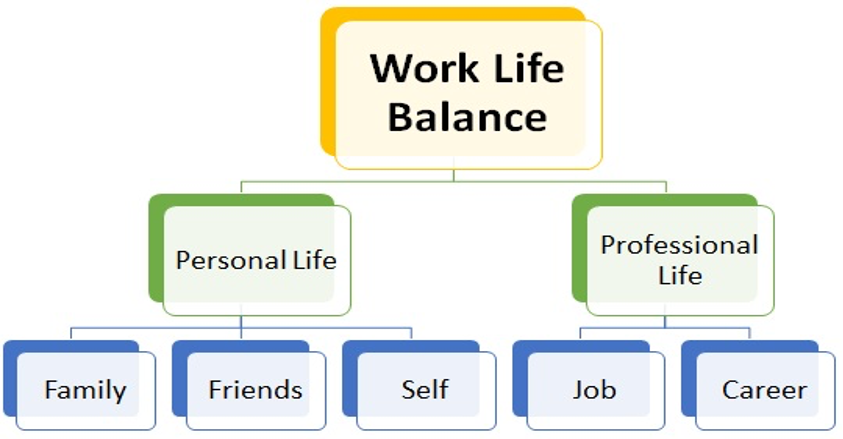
Image Showing how Work-Life Balance Occurs
The importance of work-life balance in a workplace is that it improves productivity (SpriggHR, 2020). A company must prosper for its employees to be productive. At this point, work-life balance becomes critical; if an employee’s work-life balance is steady, they will be significantly happier in their place of employment. Productivity increases as a result of this. Working overtime and staying up late every night may appear to boost production on the surface, but the work will almost likely be of worse quality due to this practice.
Another importance is that it benefits one’s physical wellbeing (SpriggHR, 2020). Excessive workloads place employees at a higher risk of developing serious physical health problems. If they do not take enough breaks during the day, this is especially the case. Here are a few illustrations: Overworking can result in pain or worsening of carpal tunnel syndrome, particularly if the workplace environment is not ergonomically designed.
AC 3.2 Explanation of What Is Meant By, And the Importance Of, Wellbeing in The Workplace
Workplace wellness refers to all aspects of a company’s operations (Berryman, 2021). The project’s scope includes, but is not limited to, providing nutritious meals, working space, workstations, and superior ergonomic equipment, so that employees may stay healthier throughout the day. Employee health is improved by including gym-like workstations, medical treatment, preventative exercise programmes, and suitable dietary planning. A healthy work atmosphere is beneficial to both physical and mental health. The benefits are
Reduced Absenteeism and Healthcare Costs
When workers are happy and healthy, they are less likely to get ill and take fewer days off (Berryman, 2021). As a consequence, the company’s absenteeism and healthcare expenditures are reduced. On the other hand, there are advantages for the business, such as greater staff productivity and work satisfaction. Employee wellness initiatives are becoming more popular. They may enhance income, staff retention, and turnover by boosting employee morale.
Increased Employee Engagement
One of the main reasons businesses established workplace wellness programmes has increased employee engagement and loyalty (Berryman, 2021). Wellness programmes allow employees to discover methods to make their job more meaningful, spend more time on it, and feel better when they return home. It leads to increased productivity and improved staff communication. It is proven that organisations with higher lee of employment engagement results int 19.2 percent increase in income compared to organisations with low level of employment engagement that experiences a decrease of 32.7 percent decrees in income.
Improved Employee Productivity and Morale
Increasing a company’s efficiency has long been a technique used by businesses. On the other hand, employees are getting more dissatisfied, which may have a negative impact on the bottom line. It is one of the key reasons prominent firms have previously implemented a wellness strategy. An increasing number of businesses are examining how workplace wellness initiatives might improve productivity, decrease absenteeism, and even promote employee retention (Berryman, 2021). Workers whose overall health are compromised as a result of overwork and stress put their social life at danger. While encouraging workers to care after themselves and achieve balance may significantly reduce health issues and absenteeism, it also allows them to work for longer periods of time without becoming fatigued.
AC 3.3 Assessment of How the Positive and Negative Aspects of Employee Engagement Can Impact the Way People Feel at Work, and the Likely Results
A workplace strategy that encourages workers to stay dedicated to the organisation’s objectives and attain their maximum performance levels is known as employee engagement (Ryba, 2021). It may be defined as the degree to which an employee is committed to their job and the amount of effort necessary to execute a task. Employee engagement levels may be high or low, affecting how people feel at work and, as a consequence, how successful a business is. When employees are comfortable and happy, employee engagement is strong. One of the various methods for boosting employee work satisfaction is to increase employee engagement. Employees that are engaged are more satisfied with their employment, which leads to improved productivity.
Increasing employees’ commitment to the company’s goals and having them do their best job are hallmarks of an organisation’s employee engagement strategy. It is an employee’s level of dedication to their job and the effort necessary to execute it. Employee engagement levels may be high or low, affecting how people feel at work and, as a consequence, how successful a business is (Ryba, 2021). When employees are comfortable and happy, employee engagement is strong. Increased employee involvement also adds to the employee’s work happiness. Employees that are engaged are more satisfied with their employment, which leads to improved productivity.
Employees provide better customer service when their engagement levels are higher (Ryba, 2021). When a company takes a customer-centric strategy, its value skyrockets, and more engaged employees are happier, which leads to better customer service and a better overall experience. The result of more engaged consumers is improved financial performance. Financial success improves when clients are satisfied with their employees’ benefits. On the other hand, disengaged personnel suggest that they are unhappy and dissatisfied, which leads to bad service and, eventually, poor financial performance.
Employee engagement influences the capacity of the workforce to innovate (Kaplan, 2019). Employees who are highly engaged are more creative and inventive, while disengaged employees are just concerned with obtaining personal goals. Employee retention and recruitment are also affected by workplace engagement. When a company focuses on employee pleasure and satisfaction, it generates a pool of committed and talented workers capable of satisfying work-related labour needs. On the other hand, employee disengagement has a negative impact on morale, resulting in a high turnover rate. More engaged employees have reduced absenteeism and, as a result, cheaper expenditures for recruitment, training, and overtime pay. When workers are disengaged, the firm suffers from absenteeism and incurs significant recruiting, training, and overtime compensation expenditures.
AC 3.4 Summary of The Main Points of Discrimination Legislation and The Impact that Discrimination Can Have Throughout the Employment Relationship
According to Falconer (2020), discrimination is mistreatment based on age, gender, marriage, disability, ethnicity, motherhood, religion, and sexual orientation. Discrimination may take many forms. The first kind of discrimination is direct discrimination, which happens when a person is not treated fairly because of their gender, colour, or sexual orientation (Falconer, 2020). Because management is prone to bias and chooses persons of its liking and choice above merit, direct discrimination is done on purpose. It creates a sour connection between workers and managers, and employees who have a bad attitude toward them are less productive and engaged.
The second kind of discrimination is unintentional indirect discrimination, which happens when a firm has specified rules, standards, and practices, but the consequences are harmful to those with protected characteristics (Falconer, 2020). The third kind of harassment is when a person is subjected to undesired conduct based on one or more of the protected qualities. Harassment happens when one person acts in a frightening, demeaning, or embarrassing way to another (Falconer, 2020). In such an atmosphere, the other individual does not feel secure. Finally, victimisation occurs when a person is treated unfairly due to speaking out against a superior (Falconer, 2020). This method prevents workers from speaking out against wrongdoings, resulting in workplace turmoil.
Impacts of Discrimination in Employment Relationship
Concerns Regarding Health
People who have been subjected to unjust treatment may experience greater stress levels, resulting in increased health concerns for them (Costello & Mains, 2019). The persistent fear of being discriminated against due to one’s ethnicity, religion, or gender may drive one to overthink wardrobe choices, discussions, and every other small thing during a person’s day. Excessive quantities of stress have been shown to impair sleep quality and cause over-or undereating. A person may become chronically unwell after developing these unhealthy behaviours.
Loss of Finance
In addition to affecting a single employee, discrimination may significantly influence a whole company (Costello & Mains, 2019). As a result of continued prejudice, businesses may suffer monetary losses. A corporation may be required to spend money to hire and train a new employee if an employee leaves because they are being harassed. A productivity consultant or a lawyer may be necessary for the company to address the underlying issues that led to the harsh treatment of the employee, even if they are still employed.
Drop-in Employee Morale
Resentment against management and other employees who benefit from unjust treatment may arise when workers feel that they are not being adequately treated in their jobs (Costello & Mains, 2019). Because of this unfavourable attitude, employees’ performance might suffer, which has a detrimental impact on the company’s overall success. In the absence of new customers, a woman may begin to miss deadlines, call in ill, or otherwise fail to meet her obligations if her male counterpart is allocated them. Her company’s reputation may also suffer due to her acts, which have a negative influence on her performance. Being treated with respect and gratitude as an employee makes her more inclined to enjoy her work and give a damn about the company’s reputation.
AC 3.5 Explanation of What Diversity and Inclusion Means, How It Differs from Equal Opportunities, and the Importance for Business and for Social Justice
The goal of inclusion is to establish a feeling of belonging in which everyone’s individuality is appreciated and respected (Bush, 2021). Understanding that each individual is unique and respecting their differences is all about diversity. By using this diversity, a productive atmosphere is created in which everyone feels appreciated, and their abilities are fully exploited to achieve personal and organisational objectives. Equal opportunity means that everyone is treated equally, regardless of biases or preconceptions. Hiring managers must treat all competent candidates equally and fairly, without discriminating based on any protected characteristic.
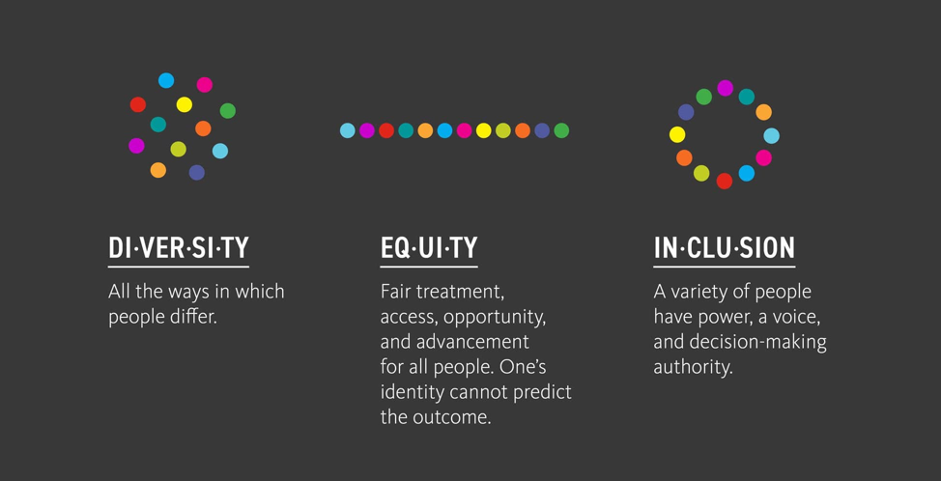 An image showing Diversity and Inclusion aspects at workplace
An image showing Diversity and Inclusion aspects at workplace
Inclusion, diversity, and equal opportunity initiatives lead to higher revenue growth (Bush, 2021). The organisation, in particular, cultivates an atmosphere in which everyone is valued, resulting in a feeling of belonging among workers. Second, it enhances one’s capacity to demonstrate creativity. It also helps the company attract and retain top talent by broadening the pool of applicants from whom to choose. Finally, it leads to a better rate of employee retention.
AC 3.6 Explanation of The Difference Between Fair and Unfair Dismissal as Defined in Legislation and as Perceived by Those Involved and Not Involved.
Fair dismissal occurs when a worker is dismissed based on code of conduct, performance, capacity, and other legal constraints, such as hidden immigration status (PJE Solicitors, 2020). It is also dependent on employee behaviour. Therefore, the employer has the power to fire an employee in specific circumstances.
A termination that is not based on an employee’s performance is known as unfair dismissal (PJE Solicitors, 2020). It differentiates between non-payment or failure to pay wages and dismissal based on an employee’s behaviour. Many different justifications depend on the corporate law in effect in the firm’s nation. Employees might be fired for becoming pregnant unless they have taken special leave. When negotiating with HR, keep a few things in mind if a firm wishes to fire a pregnant employee.
References
Berryman, E., 2021. Why Is Employee Well-Being Important at Work?. [online] CEGID. Available at: <https://www.cegid.com/en/blog/why-is-employee-well-being-important-at-work/#:~:text=The%20International%20Labour%20Organization%20defines,at%20work%20and%20work%20organization.> [Accessed 2 April 2022].
Bush, M., 2021. Why Is Diversity & Inclusion in the Workplace Important?. [online] Great Place to Work. Available at: <https://www.greatplacetowork.com/resources/blog/why-is-diversity-inclusion-in-the-workplace-important#:~:text=The%20difference%20between%20diversity%2C%20inclusion%20and%20belonging%20is%20that%20diversity,ensuring%20that%20everyone%20feels%20safe> [Accessed 2 April 2022].
Costello & Mains, 2019. The effects workplace discrimination has on employees | Costello & Mains, LLC. [online] Costello & Mains, LLC. Available at: <https://www.costellomains.com/blog/2019/07/the-effects-workplace-discrimination-has-on-employees/> [Accessed 2 April 2022].
Falconer, K., 2020. The 4 types of discrimination: what every employer needs to know. [online] HR Solutions. Available at: <https://www.hrsolutions-uk.com/4-types-of-discrimination/> [Accessed 2 April 2022].
Kaplan, M., 2019. The Link Between Employee Engagement and Innovation. [online] Linkedin.com. Available at: <https://www.linkedin.com/pulse/link-between-employee-engagement-innovation-mischa-kaplan> [Accessed 2 April 2022].
PJE Solicitors, 2020. Advice From Employment Solicitors: What Are the Differences Between Fair and Unfair Dismissals?. [online] PJE Solicitors. Available at: <https://www.pjesolicitors.co.uk/advice-from-employment-solicitors-what-are-the-differences-between-fair-and-unfair-dismissals> [Accessed 2 April 2022].
Ryba, K., 2021. What is Employee Engagement? What, Why, and How to Improve It. [online] Quantumworkplace.com. Available at: <https://www.quantumworkplace.com/future-of-work/what-is-employee-engagement-definition> [Accessed 2 April 2022].
SpriggHR, 2020. The Importance of Work-Life Balance • SpriggHR. [online] SpriggHR. Available at: <https://sprigghr.com/blog/performance-culture/the-importance-of-work-life-balance/> [Accessed 2 April 2022].
Task Five: Performance Management and Reward
Slide 1 AC 4.1
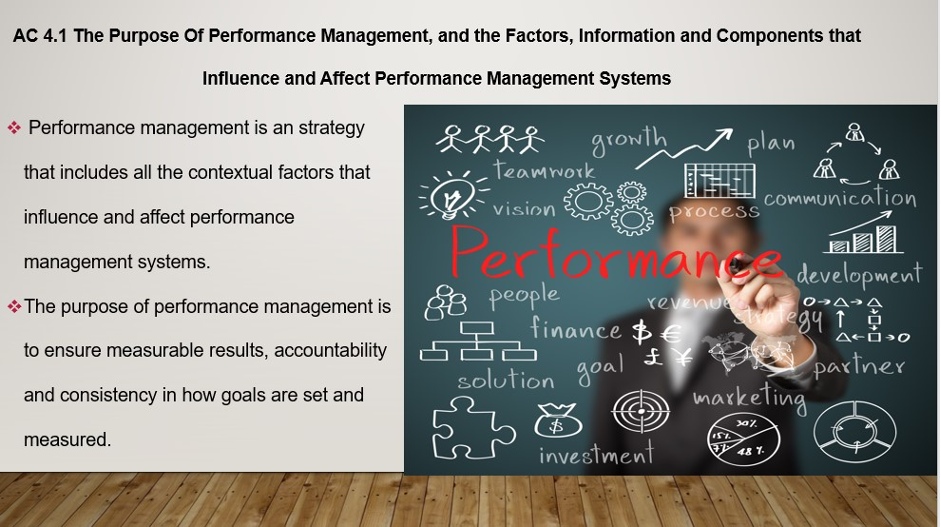 Performance management is a methodical procedure to promote a shared picture of the objectives established by the organisation and provide guidance to employees so that they may understand and maintain both individual and corporate performance (Tardi, 2021). One of the primary goals of performance management is to help employees in an organisation perform at a higher level. By allowing, encouraging, and implementing an operational incentive system, performance management helps people enhance their existing performance. It facilitates the transmission of corporate, business, and functional objectives and offers a systematic and clear opinion about the employee’s performance.
Performance management is a methodical procedure to promote a shared picture of the objectives established by the organisation and provide guidance to employees so that they may understand and maintain both individual and corporate performance (Tardi, 2021). One of the primary goals of performance management is to help employees in an organisation perform at a higher level. By allowing, encouraging, and implementing an operational incentive system, performance management helps people enhance their existing performance. It facilitates the transmission of corporate, business, and functional objectives and offers a systematic and clear opinion about the employee’s performance.
A variety of elements influences an organisation’s performance management system. These include top management and internal management dedication, internal resources, a performance-oriented culture, staff involvement, and PMS maturity (Tardi, 2021). The development of an efficient performance measurement system requires strong leadership. There may impact workers’ dedication towards meeting or exceeding their objectives if management commits themselves in this way. Internal resources, such as time and effort, may be required to set up measurement and management systems at the beginning of the process. There are several ways to think about culture, including the sum of views, ideologies, behaviours, and values that are prominent in an organisation. Employee involvement and motivation might significantly influence the development of the performance management system. The deployment and outcomes of a performance management and measurement system will be affected by previous experience in the field.
Slide 2 AC 4.2
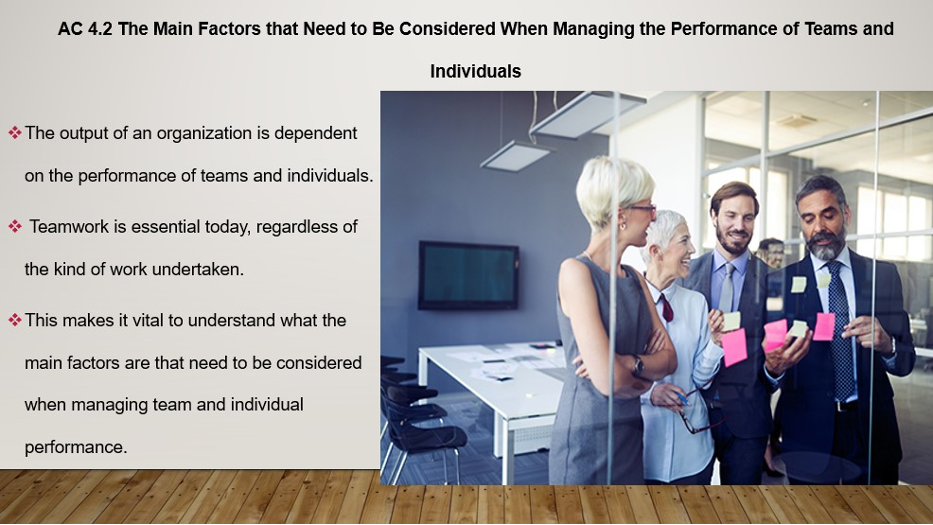 This can positively or negatively impact an organisation’s overall success based on how its personnel and teams are managed and led (Black et al., 2019). Developing an integrated management strategy is not easy, but it is vital to elicit employee commitment. It is possible to utilise incentive systems as a change mechanism to foster a more performance-oriented work environment; rules that encourage common objectives and include rewards for workers increase their commitment. Good management makes it easier for employees to follow instructions and absorb information.
This can positively or negatively impact an organisation’s overall success based on how its personnel and teams are managed and led (Black et al., 2019). Developing an integrated management strategy is not easy, but it is vital to elicit employee commitment. It is possible to utilise incentive systems as a change mechanism to foster a more performance-oriented work environment; rules that encourage common objectives and include rewards for workers increase their commitment. Good management makes it easier for employees to follow instructions and absorb information.
Motivation
Employees’ expectations for engagement and growth in the workplace have shifted significantly. The range of views on the role motivation plays in enhancing performance may be explained by a sense of historical progression. To effectively manage individual performance, one must first identify areas of strength and growth for each person.
Personal Performance
Team performance may be measured and managed via management models that provide quantitative and qualitative feedback (Black et al., 2019).. People and teams must match their goals with the general objectives of the organisation because performance management has an evaluative and developmental aspect to it, which links performance to incentives and provides a visible and quantifiable platform for the growth of the person.
Slide 3 AC 4.3
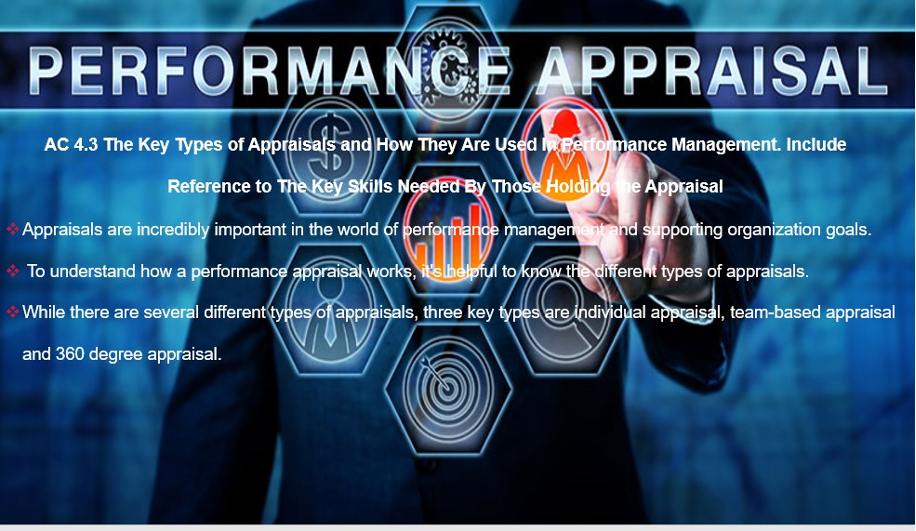 360-degree Feedback Appraisal
360-degree Feedback Appraisal
This technique is essentially the same as a group performance evaluation. Employees’ coworkers may be able to provide feedback on their performance in a range of scenarios and conditions that may have gone unnoticed by the employer (Beqiri, 2018). This enables the provision of comprehensive, full-circle feedback on an individual. This strategy is advantageous since it removes the element of subjectivity. It also fosters open culture, self-development, and improved communication. Organisation must build an efficient system and process to make use of this strategy.
Behaviourally Anchored Rating Scale (BARS)
This strategy involves using a checklist to evaluate employees. Personnel in charge of creating the checklist might include whichever criteria they see fit (Performyard, 2021). The checklist’s items are assigned a numerical value based on how critical they are to successful work. When all of these elements are considered, the overall assessment score is determined. If an employee satisfies these requirements, they are eligible for an evaluation. The checklist technique makes it simple for managers to evaluate their staff. It also makes it easier for workers to get honest feedback. However, creating a useful checklist and determining its weighting based on the relevance of various elements may be difficult.
Slide 4 AC 5.1
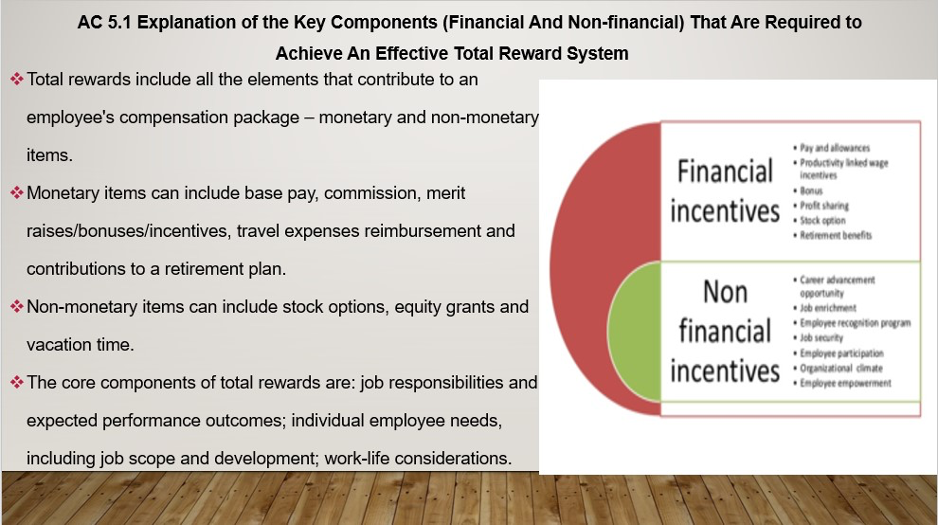 Other forms of financial reward include bonuses, raises, paid vacation, and other forms of compensation (Cotton, 2021). Providing financial incentives to employees encourages them to do their best, enabling them to do best. Non-financial rewards might include a better work environment and the opportunity to grow professionally (Cotton, 2021). For example, one may award a trophy to the company’s most successful salesperson at the end of the year. Sellers who receive public acclaim find it extremely motivating, but it also drives them to compete with one another.
Other forms of financial reward include bonuses, raises, paid vacation, and other forms of compensation (Cotton, 2021). Providing financial incentives to employees encourages them to do their best, enabling them to do best. Non-financial rewards might include a better work environment and the opportunity to grow professionally (Cotton, 2021). For example, one may award a trophy to the company’s most successful salesperson at the end of the year. Sellers who receive public acclaim find it extremely motivating, but it also drives them to compete with one another.
Employee recruitment and retention can be aided to some extent by financial incentives. New workers and young professionals find non-monetary rewards enticing, but they also can affect the rest of the firm favourably. Emotional connections and strong motivation can be fostered, and financial ones through non-cash rewards. All of this results in a long-term increase in employee loyalty. While non-monetary incentives have an emotional component that monetary incentives do not, after spending their prize on paying expenses, employees forget about it. Therefore, it is recommended to conduct a cost-benefit analysis to identify what financial perks the organisation can include and then supplement that list with some carefully selected non-monetary incentives.
Slide 5 AC 5.2
 When employees believe their efforts are fully acknowledged and compensated, they perform at their highest level. Motivation is persuading others to act, think, and behave in a certain way (Manzoor, Wei and Asif, 2021). Employee motivation and performance go hand in hand since a motivated employee performs considerably better than one who is demoralised. According to Maslow’s Motivational Theory, essential human needs influence one’s willingness to work: safety and self-esteem (Manzoor, Wei and Asif, 2021). Employees’ desire to work hard is determined by their financial and personal security and wellbeing; if there is no such assurance, do not expect them to work hard. Personal and financial security, on the other hand, boosts performance. Individual performance is heavily influenced by self-perception; if employees believe that their colleagues and management do not regard them, their self-esteem plummets.
When employees believe their efforts are fully acknowledged and compensated, they perform at their highest level. Motivation is persuading others to act, think, and behave in a certain way (Manzoor, Wei and Asif, 2021). Employee motivation and performance go hand in hand since a motivated employee performs considerably better than one who is demoralised. According to Maslow’s Motivational Theory, essential human needs influence one’s willingness to work: safety and self-esteem (Manzoor, Wei and Asif, 2021). Employees’ desire to work hard is determined by their financial and personal security and wellbeing; if there is no such assurance, do not expect them to work hard. Personal and financial security, on the other hand, boosts performance. Individual performance is heavily influenced by self-perception; if employees believe that their colleagues and management do not regard them, their self-esteem plummets.
Slide 6 AC 5.3
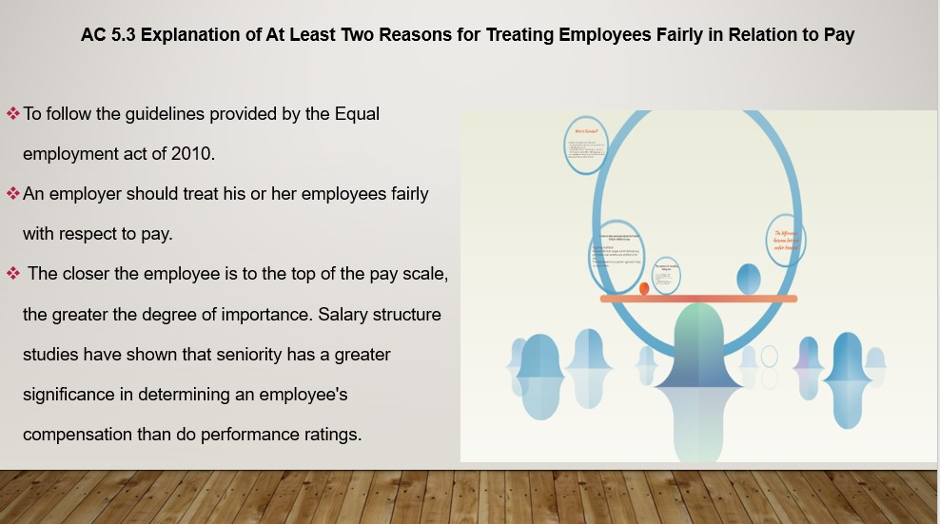 There is so much wage rivalry is a major motivator for employers to ensure that their workers are paid properly. Employers want to be better than their competitors. However, they also want to keep their employees happy and appreciated, which means that employees will be more productive if they feel valued and are paid what their job warrants. If they see that their job is elsewhere for a vast increase in wage, they will wonder why they are worth that much money elsewhere and not at their current place of employment. The Equal Wages Act of 2010 is another reason it is critical to treat employees properly when paying. Everyone in the company should be treated fairly in every way possible, ensuring that no one is being treated better or worse than anybody else. It enhances the wellbeing of workers, spurring them on to greater levels of productivity and dedication, ultimately leading to a higher percentage of employee retention.
There is so much wage rivalry is a major motivator for employers to ensure that their workers are paid properly. Employers want to be better than their competitors. However, they also want to keep their employees happy and appreciated, which means that employees will be more productive if they feel valued and are paid what their job warrants. If they see that their job is elsewhere for a vast increase in wage, they will wonder why they are worth that much money elsewhere and not at their current place of employment. The Equal Wages Act of 2010 is another reason it is critical to treat employees properly when paying. Everyone in the company should be treated fairly in every way possible, ensuring that no one is being treated better or worse than anybody else. It enhances the wellbeing of workers, spurring them on to greater levels of productivity and dedication, ultimately leading to a higher percentage of employee retention.
The Equal Pay Act requires that men and women receive equal pay for equal work, based on skill, effort, and responsibility. Although employers can pay different rates to employees who perform equal work, the differences in their compensation cannot be based on their gender. Companies who pay male and female employees fairly can attract and retain high-quality talent. Gender pay gap is one of the key indicators of gender equality in the workplace, showing how women’s earnings compare to men.
Slide 7 References
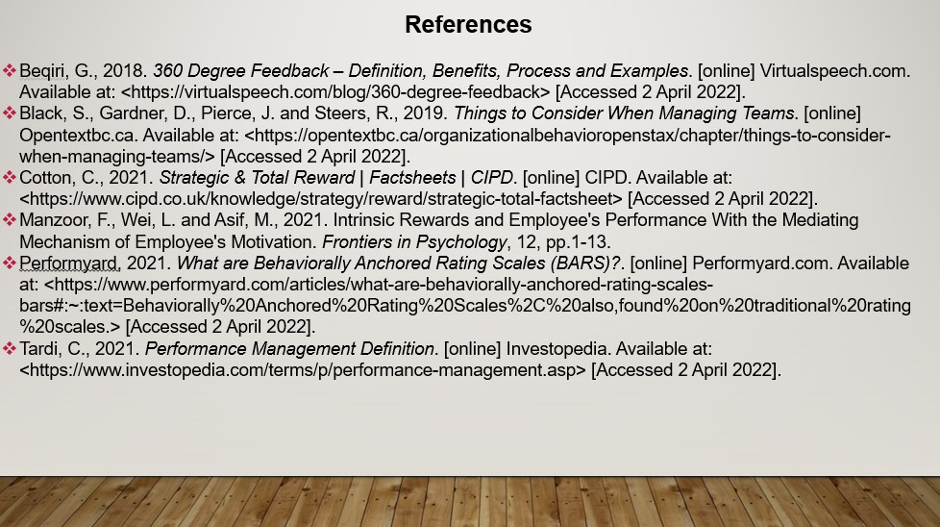 Task 6: Supporting Skills and Knowledge Development in the Workplace
Task 6: Supporting Skills and Knowledge Development in the Workplace
AC 6.1: Examples of Different Learning Needs that Might Arise for Individuals and Organisations, Explaining How They Might Arise
Communication Skills
Potential employers are more likely to notice a candidate’s ability to communicate early in the interview process (Malec, 2022). The employer will scrutinise an employee’s behaviour from the minute they first contact them. They may be seen whenever the management team proofreads each written message they send out and when they listen to their public communication to see whether it satisfies their requirements.
Leadership Skills
To do so, a person must have the capacity to manage a team and oversee personnel in a way that does not impede progress or undermine their judgement. This is a skill that is greatly sought in today’s jobs.
Problem Solving Skills
Some job functions need the ability to make quick decisions. One employee’s ability to recognise complex difficulties, analyse new ideas, create, assess, and implement solutions differentiates them from the rest of the workforce (Malec, 2022). Individuals who have the ability to use critical thinking to try to justify a judgement will stand out from the crowd. When workers are given additional tasks or are promoted, this might happen to them.
Analytical Skills
One feature that distinguishes one individual from another is the ability to be analytical while also conducting a comprehensive choice. A person’s perseverance, capacity to analyse various decisions, and devotion to being certain before answering a question from an employer are all reflected in their work ethic. In certain cases, it might make the difference between a poorly thought-out plan and one that generates revenue for the organisation. These learners at the management level are needed to take this training as a refresher course. The need for this may occur when the senior management team becomes aware of bad judgements made by one or more of the management team members.
Interpersonal Skills
This pertains to the participant’s capacity to establish relationships with others in various contexts and their ability to motivate them to complete activities on their own (Malec, 2022). As a result of frequent conflicts amongst employees in an organisation, this trait is perceived as lacking and may be observed, resulting in the requirement for training to address the issue.
AC 6.2: A Summary that Briefly Explains Different Approaches Learning, which Must Include At Least: Facilitation, Consulting, Training, Coaching, and Mentoring
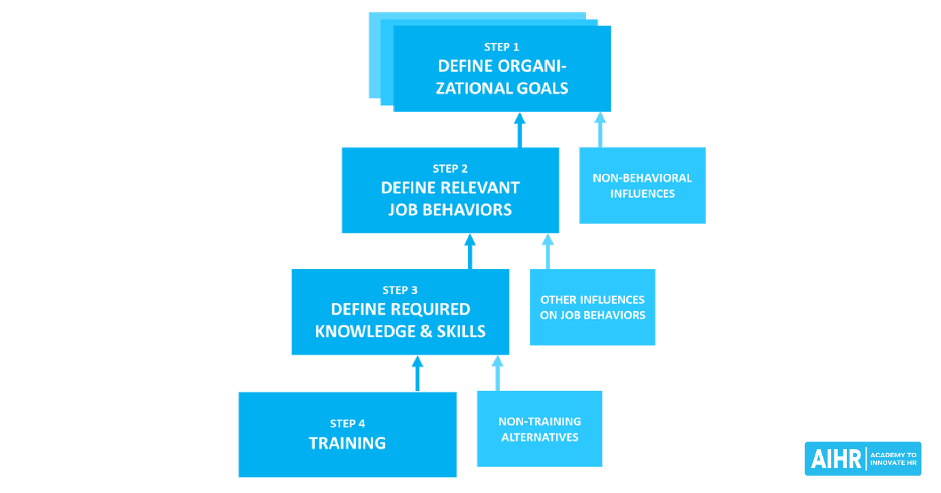 Training/Facilitation
Training/Facilitation
Trainers use training strategies to aid individuals in learning, maintaining, and applying their knowledge and abilities to new circumstances (Berteig, 2020). Participants are introduced to the topic and then asked questions, with the trainer guiding the dialogue, offering comments, and making every effort to improve the learners’ overall learning experience.
Coaching
Employer-provided workplace coaching provides employees with the skills, knowledge, and opportunities that they require to grow appropriately and be effective in their devotion to themselves, the organisation, and their job (Hayden, 2021). Coaching is concerned with removing performance impediments and the encouragement of creativity. It is concerned with the growth, development, and accomplishment of employees.
Mentorship
This is a structured relationship between coworkers with the objective of learning and progressing in their respective positions of responsibility (Hayden, 2021). In most cases, the notion of having a mentor at work is connected with older and more experienced workers providing direction and support to newer and more inexperienced employees who are just starting in their professional careers.
Consultation
Employers might benefit from the services of a consultant who can supply them with insights on an as-needed basis (Berteig, 2020). Project management, stakeholder management, and issue resolution are just a few of the skills that the chosen consultant should possess and a full understanding of the client organisation.
AC 6.3: An Explanation of How, In the Design and Delivery of Learning and Development Initiatives, Individual Requirements and Preferences Must Be Accommodated
Training programmes that are properly designed encourage employees’ professional development while also preparing them to perform successfully in their current positions. It is permissible to use an ADDIE model when developing and implementing a learning and development effort that meets the requirements and preferences of employees (Quigley, 2019). Before designing any content or training approaches, it is vital to analyse the present situation in terms of knowledge gaps to suit a variety of audiences. Immediately following the completion of the training plan, the design phase begins. During this phase, all prior information is used to make practical decisions, and all stakeholders are involved in the plan’s creation. In accordance with the design phase, each part of the work should be created in its own right. The primary purpose of ADDIE is to make the process of developing well-organised training programmes easier. Nonetheless, it is a useful model for improving how subsequent iterations are developed through assessment and feedback.
AC 6.4 Examples of At Least Two Methods of Evaluating Learning and Development and Its Impact, and How Evaluation Benefits Both Individuals and Organisations
Employee participation and financial reporting are the two most often utilised learning techniques in the workplace (Jouany and Martic, 2020). Calculating employee attendance, work completion, and follow-up tracking may all be used to assess their level of engagement. A circumstance in which an employee has displayed entire or partial involvement in the operations of an organisation or firm, often to meet financial responsibilities, is known as employee participation (also known as employee involvement). It refers to how employees are dedicated to their employees and consider their occupations vital to their personal lives. Employee participation also refers to the engagement of employees in choices that concern them, such as those that influence their safety and the wellbeing of their coworkers and the capacity of employees to participate in decision-making processes at their place of employment. Because of higher productivity and lower turnover rates, there is a clear inference that increased employee engagement results in increased productivity rates and low absence rates without the need for increased personnel expenses.
The financial report analysis is carried out to determine if the company’s sales and profits have improved due to implementing the essential learning techniques for its personnel. When the financial condition is good, the employees gain valuable knowledge via the use of effective learning models. It improves the financial condition of the organisation as well as the opportunities for individual career and progress.
References
Berteig, M., 2020. Agile Coaching, Mentoring, Facilitating and Training – What is the Difference? – BERTEIG Consulting and Training. [online] BERTEIG Consulting and Training. Available at: <https://berteig.com/coaching/coaching-mentoring-facilitating-and-training-what-is-the-difference/> [Accessed 2 April 2022].
Hayden, D., 2021. Coaching and Mentoring | Factsheets | CIPD. [online] CIPD. Available at: <https://www.cipd.co.uk/knowledge/fundamentals/people/development/coaching-mentoring-factsheet> [Accessed 2 April 2022].
Jouany, V. and Martic, K., 2020. Top 15 Employee Motivation Tips and Benefits. [online] Blog.smarp.com. Available at: <https://blog.smarp.com/top-15-employee-motivation-tips-and-benefits> [Accessed 2 April 2022].
Malec, M., 2022. How to Identify Learning Needs in Your People. [online] Learnerbly.com. Available at: <https://www.learnerbly.com/articles/how-to-identify-learning-needs-in-your-people> [Accessed 2 April 2022].
Quigley, E., 2019. ADDIE: 5 Steps To Effective Training. [online] LearnUpon. Available at: <https://www.learnupon.com/blog/addie-5-steps/> [Accessed 2 April 2022].
3CO04 Assignment Example 2025 / 2026
Click To Open



